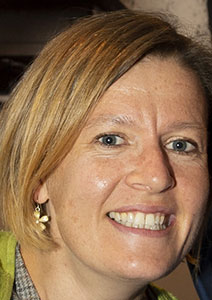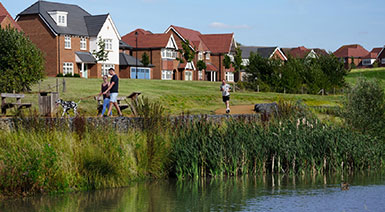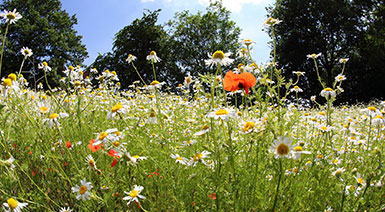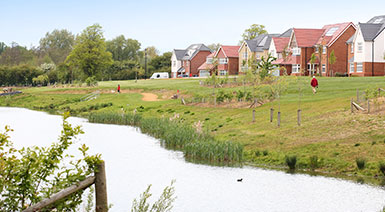
Rosie Whicheloe, a landscape ecologist at The Wildlife Trusts, shares her insights from her secondment with leading housebuilder Redrow.
To enable change, I’ve always believed it’s important to understand the system, straddle across disciplines and get to know how a company works from the inside. That’s why this last year has been so rewarding for an ecologist like me. I have been lucky enough to work on secondment for a leading housebuilder Redrow, working with them to shape their biodiversity strategy in a partnership-led approach with The Wildlife Trusts.
Working as a ‘critical’ friend
This marked the first time a representative from The Wildlife Trusts has been seconded to a housebuilder, with the aim of developing its biodiversity strategy and objectives. My role over the last year has been to act as a “critical friend”, identifying what ‘good’ looks like, whilst also highlighting the issues of current practices that need to be addressed and resolved.
We’re working with different functions and divisions across the business, not just Redrow’s sustainability team, and so it’s been important for me to explain the concept of biodiversity net gain, what the new Department for Environment, Food and Rural Affairs (DEFRA) metric will require from the business and how this will affect work streams and scope of external consultants. Engaging with Redrow’s engineers, design managers and planning directors has formed an important ongoing thread to the strategy as they will be the ones implementing the strategy. Working with companies at the ‘grassroots’ level is very much in line with our focus at The Wildlife Trusts, as we generate the best results through empowering people through knowledge and engagement.

Engaging with the whole business
Through this strategy, Redrow will be engaging the whole business, from the sales and commercial teams, through to consultants, contractors, and even existing and future customers. In my short time with Redrow, I’ve noticed staff have a genuine sense of pride for their developments and a real interest and passion for the aims of this strategy.
The Government’s intention to make biodiversity net gain compulsory through the planning system was a driver for this strategy, but Redrow have long recognised that people are an important part of the equation too, and so do the Wildlife Trusts. This means we need to restore nature on a massive scale – not only where we work and play but also where we live. Yet, environmental organisations can’t achieve this without collaborating with others such as house builders. We need to apply the Lawton concept of being better and more joined up to our habits as well as our habitats. Redrow’s strategy with The Wildlife Trusts brings together expertise from two historically conflicting sectors to find a way to put nature at the heart of designing new places in which to live.

The experience
To provide some further detail on my experience, from the beginning of my secondment I worked alongside Redrow’s Group Sustainability Manager, Nicola Johansen, travelling across England and Wales, meeting each of the housebuilder’s 13 regional divisions and visiting local sites. We provided training and a forum for employees to contribute to the strategy and address any concerns they had.
Visiting completed development sites was a hugely useful part of these visits. It allowed me to see how designs are being implemented and managed. From a personal perspective, I’ve been moseying around new developments for some years, critiquing the landscapes and their ecological value, whilst trying to understand how the design could be improved. I have often left feeling hollow, saddened by the missed opportunities: the over-engineered design, the focus on cars not people, planting of ever-so exotic evergreens that do nothing for local wildlife or distinctiveness, hedgerows truncated and replaced with fences, expanses of lawn that mask the character and diversity of the former landscape. So, I almost felt liberated to explain what I was seeing on Redrow’s sites to a captive audience. The response could not have been more positive with employees responding with keenness to understand and amend their approach to site design and land management.
The biodiversity working group
The biodiversity working group has been an invaluable forum for the strategy. Comprising expertise from both organisations, as well as The Bumblebee Conservation Trust, who have a long-term partnership with Redrow, the group has identified several quick wins, whilst troubleshooting possible solutions to more complex issues.
It’s a brave step for any developer to open their business up to scrutiny. Developers often get the blame for ruining the countryside, but it’s not always their fault. Redrow, like other developers, are in the middle of a much bigger system with many other players pushing and pulling to get what they want. Through the strategy, we hope to provide further clarity on the decision web that influences development outcomes and in doing so help engage with communities and external organisations to better understand and hopefully support what Redrow is trying to achieve.
The next stage of the strategy, which will be announced in due course, is about pushing ahead with updating a number of key processes within the business. This includes land purchasing, internal design guidance, layout review, as well as engaging and providing guidance to consultants, contractors and management companies. It’s a system change that is massively important and great to be part of.

Rosie Whicheloe is a landscape ecologist, working for London Wildlife Trusts consultancy. She works with local authorities, developers and design teams, helping them to maximise biodiversity through design and land management. She is a full member of Chartered Institute of Ecology and Environmental Management (CIEEM) and an associate member of the Landscape Institute.
https://www.gov.uk/government/news/making-space-for-nature-a-review-of-englands-wildlife-sites-published-today



